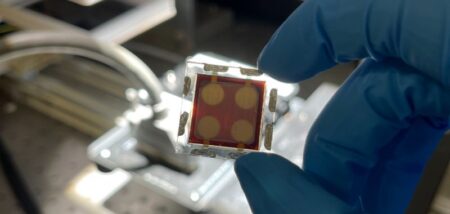Jan
12
Tough Stable Perovskite Design Now Compares To Silicon
January 12, 2023 | Leave a Comment
By removing the solvent dimethyl-sulfoxide and introducing dimethylammonium chloride as a crystallization agent, the researchers were able to better control the intermediate phases of the perovskite crystallization process, leading to thin films of greater quality, with reduced defects and enhanced stability.

A mini prototype solar panel featuring these cells achieved 18.8% efficiency. Image Credit: © The ARC Centre of Excellence in Exciton Science 2020. Click this link for the largest view.
Large groups of up to 138 sample devices were then subjected to a rigorous accelerated ageing and testing process at high temperatures and in real-world conditions.
The formamidinium-caesium perovskite solar cells created using the new synthesis process significantly outperformed the control group and demonstrated resistance to thermal, humidity and light degradation.
The results show a strong step forward to matching commercial silicon’s stability and makes perovskite-silicon tandem devices a much more realistic candidate for becoming the dominant next-generation solar cell.
Oxford University PhD student Philippe Holzhey, a Marie Curie Early Stage Researcher and joint first author on the work, said, “It’s really important that people start shifting to realize there is no value in performance if it’s not a stable performance. If the device lasts for a day or a week or something, there’s not so much value in it. It has to last for years.”
During testing, the best device operated above the T80 threshold for over 1,400 hours under simulated sunlight at 65°C. T80 is the time it takes for a solar cell to reduce to 80% of its initial efficiency, a common benchmark within the research field.
Beyond 1,600 hours, the control device fabricated using the conventional dimethyl-sulfoxide approach stopped functioning, while devices fabricated with the new, improved design retained 70% of their original efficiency, under accelerated aging conditions.
The same degradation study was performed on a group of devices at the very high temperature of 85°C, with the new cells again outperforming the control group.
Extrapolating from the data, the researchers calculated that the new cells age by a factor of 1.7 for each 10°C increase in the temperature they are exposed to, which is close to the 2-fold increase expected of commercial silicon devices.
Dr David McMeekin, the corresponding and joint first author on the paper, was an Australian Center for Advanced Photovoltaics (ACAP) Postdoctoral Fellow at Monash University and is now a Marie Skłodowska-Curie Postdoctoral Fellow at Oxford University. He said: “I think what separates us from other studies is that we’ve done a lot of accelerated aging. We’ve aged the cells at 65°C and 85°C under the whole light spectrum.”
The number of devices used in the study is also significant, with many other perovskite research projects limited to just one or two prototypes.
“Most studies only show one curve without any standard deviation or any kind of statistical approach to determine if this design is more stable than the other,” Dr McMeekin added.
The researchers hope their work will encourage a greater focus on the intermediate phase of perovskite crystallization as an important factor in achieving greater stability and commercial viability.
The work was supported by the Stanford Linear Accelerator Center (SLAC) and the National Renewable Energy Laboratory (NREL).
***
This is real progress. Perovskites are low cost, flexible, tunable to a band gap and getting pretty efficient – but, they degrade quickly out in the elements. They really don’t like high temperatures and moisture thus, well, falling apart so to speak.
That makes this team’s work significant. 85°C is pretty warm for out in the elements. That might be high enough depending on how warm the units themselves get in say, death valley conditions.
The other issue is moisture. Humidity isn’t quite like a rainstorm with a driving wind. We’re watching for news on that angle and hoping that the tech, when found, will be manufacturing process friendly to the heat mastering innovations. As PhD student Holzhey said, these things have to last for years.

